  These insects are members of the insect order Odonata, which includes not only true dragonflies but also the closely related damselflies. There are roughly 5,900 species, of which about 3,000 are dragonflies, and about 2,600 are damselflies.
These insects are members of the insect order Odonata, which includes not only true dragonflies but also the closely related damselflies. There are roughly 5,900 species, of which about 3,000 are dragonflies, and about 2,600 are damselflies.Dragonflies and damselflies are both predatory flying insects that look primitive and ancient because they are; prehistoric species hundreds of millions of years ago were quite similar to the modern species, just considerably larger! Some had wingspans of more than 71 centimetres; today's largest species have only a 17 cm wingspan. Modern dragonflies and damselflies are most often found in tropical regions, but some species can be found in almost every part of the world, except for the polar regions. Dragonflies and damselflies are often confused with one another because they share many characteristics, including membranous wings, large eyes, slender bodies, and small antennae. But there are differences: dragonflies are studier, thicker-bodied insects, while damselflies have longer, thinner bodies. Both dragonflies and damselflies can be seen in a wide range of sizes and colours. Colors may be dull, but many have bright metallic hues of greens and blues. All have biting mouth parts, a long narrow abdomen, large compound eyes, and small thread-like antennae. Their two pairs of membranous veined wings cannot be folded flat over their abdomen. 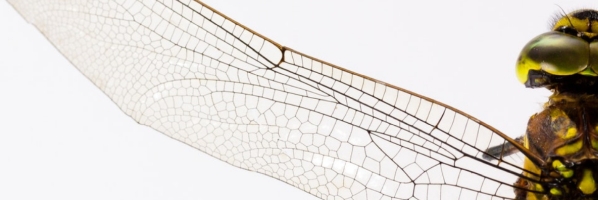 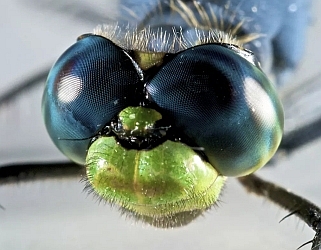 Prehistoric-looking dragonflies can be scary as they swoop about, but they are harmless to humans. They feed on pests like mosquitoes and midges, but are also strong enough to capture a bumblebee in flight.
Prehistoric-looking dragonflies can be scary as they swoop about, but they are harmless to humans. They feed on pests like mosquitoes and midges, but are also strong enough to capture a bumblebee in flight. Dragonflies have very good vision which helps them detect the movement of other flying insects. Their two huge compound eyes have nearly 360° vision and can see a wider spectrum of colors than humans. Each compound eye contains 28,000 lenses, and a dragonfly uses about 80% of its brain to process all of the visual information it receives. Dragonflies lay their eggs in or near water. Hatched larvae or nymphs go through a series of molts, and begin predatory feeding on the larvae of other insects, and vertebrates such as small fish and tadpoles. The larvae themselves are also an important food source for fish, amphibians, and birds. Larval dragonflies and damselflies reach adulthood in as little as three weeks, or as long as eight years, depending on species. They go through no pupal stage, but near the end of the larval stage, the insects begin to develop wings, which become useable after the last molt. 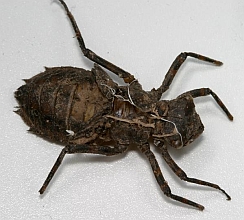 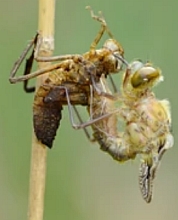 Dragonfly and damselfly nymphs both breathe through gills inside their rectum. They pulls water into the anus to breathe. When the nymph expels water, it propels itself forward, providing the added benefit of locomotion. The adult flying stage, which can last as long as nine months, includes attacking and feeding on other insects, mating, and laying eggs in water or moist, marshy areas. As adults, dragonflies and damselflies have almost no predators, except for some birds. Not only do these insects pose no danger to humans, but they consume large quantities of mosquitoes, gnats, and other biting insects. 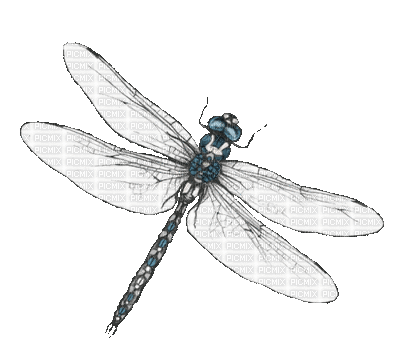 Dragonflies are able to move each of their four wings independently. They can flap each wing up and down, and rotate their wings forward and back on an axis.
Dragonflies are able to move each of their four wings independently. They can flap each wing up and down, and rotate their wings forward and back on an axis.Dragonflies can move straight up or down, fly backward, stop and hover, and make hairpin turns - all at full speed or in slow motion. A dragonfly can fly forward at a speed of up to 50 km/h. A number of dragonfly species are known to migrate, either singly or en masse. Green darners, for example, fly south each fall in sizeable swarms and then migrate north again in the spring. 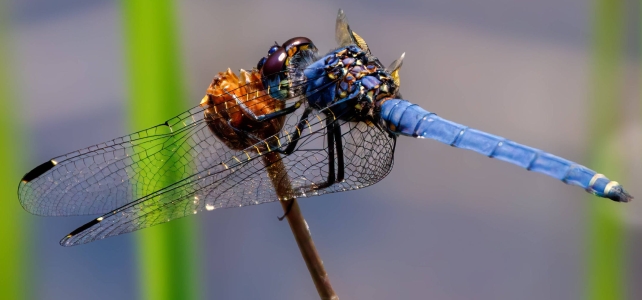 

 |